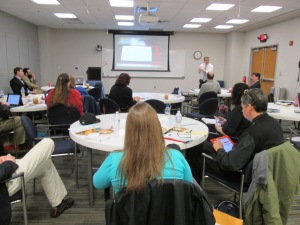Exploring Online Collaborations
Last month, North Carolina’s Department of Cultural Resources Education & Outreach Branch, which includes our C2C team, hosted a meeting for history field service agents across the country. Members of the Field Services Alliance, an affinity group of AASLH (American Association of State and Local History), do what we do in their respective states and regions. They reach out to staff (both paid and volunteer) at state and local history organizations with training opportunities, technical assistance, and other support services. This year’s meeting focused on online collaborations to support our work. Because the nature of field services involves travel time, which in turn costs money, our group was eager to learn about ways that online interactions could help us serve our constituents.
Have you ever signed onto a webinar with a particular question in mind? Did you have to wait long for an answer, if you were ever able to ask in the first place? Webinars are usually one-to-many presentations with limited opportunities for audience participation. We’ve experienced webinars that scheduled brief question & answer sessions at the very end, when most participants were beginning to sign off. Learning from other participants’ questions and responses can be the best part of group training, but the typical webinar format often limits this potential enrichment.

image credit: http://fonolo.com/google-hangout-customer-experience/
Several of our cohorts in other states offer training sessions for the non-profit boards that govern history organizations. What would be the best way to engage these constituents online, to encourage collaboration? We need something easy and, in most cases, free or low-cost. Other field services offices have important statewide networks that need to meet regularly for planning and updates, like CREST here in NC. A feasible online solution would be a welcome alternative to conference calls, where everyone who is able to join live tends to stare at the spider-looking thing in the center of the conference table, and speakers have to lean in and talk loudly to be heard.
Two guest speakers at the meeting discussed online collaboration options, including state-of-the-art budget-busters and a great learning platform (though not always collaborative), developed by UNC, Learn NC. The solution with the most promise for our field service applications, however, is one which some FSA members are already using. Google Hangout is free for up to 20 users and has $19/ month fees for up to 100. Newly developed applications even allow Hangouts to incorporate slide share, whiteboard, and scoot&doodle.
To participate in a Google Hangout, you need a computer (or mobile phone) with a webcam and speakers, and you have to set up a (free) Google+ account. The executive director of Learn NC warned us during our meeting that online collaborations can never replace the value of face-to-face interactions. But these methods have promise to assist in building professional learning communities more effectively and efficiently. Does Google Hangout sound like a group communication method that would be helpful to you, either as a way to participate in professional training or networking or as a way to engage interest groups for your own site?
Posted on March 25, 2014, in public programs, workshops and tagged AASLH, Andy Mink, board training, Learn NC, statewide museum field service. Bookmark the permalink. 1 Comment.

Thank you for hosting the Field Services Alliance! It was a great meeting.
Stuart Sanders
Kentucky Historical Society